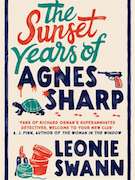Feeding a sleuthing habit – The Sunset Years of Agnes Sharp and its questionable culinary delights

I suspect that a lot of people secretly dread being acquainted with an author.
Writers can be scatterbrained. They tend to watch you with a weird glint in their eyes. They never seem to be doing any proper work. And then there is always the nagging question: am I going to end up in a book somehow?
In the past, no matter whether I wrote about sheep, parrots, fleas or pensioners, my friends and family seemed to be constantly worried: did you take them from life? Are they inspired by people you know? Am I somewhere in there? (Please, let it not be so!)
The short answer is “no”.
I am not sure where other authors find their characters, but I am very certain that mine have never inhabited the same plane of reality as the people around me. Neither do I just make them up. The process is a lot simpler and more mysterious than that. My characters walk in through a door in my head, blink and make themselves at home.
Getting to know them, page by page, scene by scene, is one of my favourite things about writing, and the work on my latest novel The Sunset Years of Agnes Sharp has been especially rewarding in that respect. Simply put, I fell in love with my aged amateur sleuths from the get-go: bright and brittle Agnes Sharp and her sidekick Marshall, conciliatory Winston, blind but cool Bernadette, flamboyant Charlie, delightfully unhinged Edwina and – last but by no means least – Hettie, the trusty household tortoise.
I am not sure how they feel about me, though.
Granted, I have endowed them with a lot of pluck and determination and provided them with a string of exciting adventures – but I also serve them a lot of questionable foodstuffs.
Setting aside the odd murder, the house share of Sunset Hall has a lot going for it: the community spirit, the garden, the company and above all the tortoise. However, one thing is certain: the food is deplorable. Agnes and her gang do not have a culinary bone in their body, their shopping lists are haphazard, their suppers are made up of the soft, the dubious, and the ready-made. Even the Chelsea buns baked by their help Silvie turn out deformed and anaemic.
The food in the book might not be good – but it is important. All the chapter titles are made up of foods consumed in the respective chapter – a rather sorry procession of stews, bangers and mash, takeaways, and tinned soups.
This is not random, of course. Food tells you a lot about the one who consumes it, and for all its blandness, the stuff served up in Sunset Hall is a choice. My protagonists favour practicality, autonomy and chewability rather than comfort and indulgence. They have opted to spend their sunset years independently and self-reliantly, and if culinary expectations must be dialled down for that, so be it. They would rather eat pea soup heated up on their own steam than a fresh, balanced meal in the confines of a luxury care home. They would rather investigate the murder at their doorstep armed with walking sticks and collection tins, than leave everything to the overtaxed local police officers.
It is a wise choice, as far as I’m concerned.
Edwina’s biscuits may not be suitable for consumption, but they are excellent at deterring unwanted visitors, can serve as instruments of torture and are unsurpassed as missiles in case of an emergency.
Chicken soup might not be an exciting choice per se, but it is helpful when it comes to reviving a burglar or calming your own frayed nerves.
Hot milk consumed at night might not make you sleepy, but waiting for it to cool down to a drinkable temperature certainly will.
G&T is not strictly speaking a food but can be enjoyed at all times.
Luckily for my protagonists, not all the comestibles in The Sunset Years of Agnes Sharp are tasteless. There is good stuff to be found if you go further afield: canapés, cream slices, Victoria sponge, cottage pie and other mouthwatering goods will be encountered during their investigative jaunts to the village, the neighbour’s mansion, the upmarket local care home.
But these delights come at a price.
The wealthy elderly neighbour dines in luxury, but she is practically a prisoner in her own home. To enjoy meals at the care home you have to give up your freedom and very likely your dignity and sanity as well. The canapés are served at the funeral of a murder victim, the cottage pie might be laced with poison and the cream slices could have been prepared by a murderer. Death lurks underneath the indulgence, palatable calories come at a cost – after all, you can’t have your cake and eat it.
Good food might just be a bait, a trap, and Agnes and her friends refuse to be snared, not while solving the case and not in life. After all, there are more important things than filling your stomach. When the final confrontation with the murderer happens rather pleasantly over tea and scones, it is no accident that Agnes fends off her adversary armed with a fork and a spoon.
Are the culinary hardships of Agnes Sharp and her gang taken from life, some may wonder – especially those who have been asked round for dinner at mine. I can reassure them: just like my characters, my fictional foods are entirely made up. At home, my biscuits are moist and supple, my soups cooked from scratch and my cream slices guaranteed murder-free.

Published by Allison & Busby
September 28, 2023, Hbk & eBook